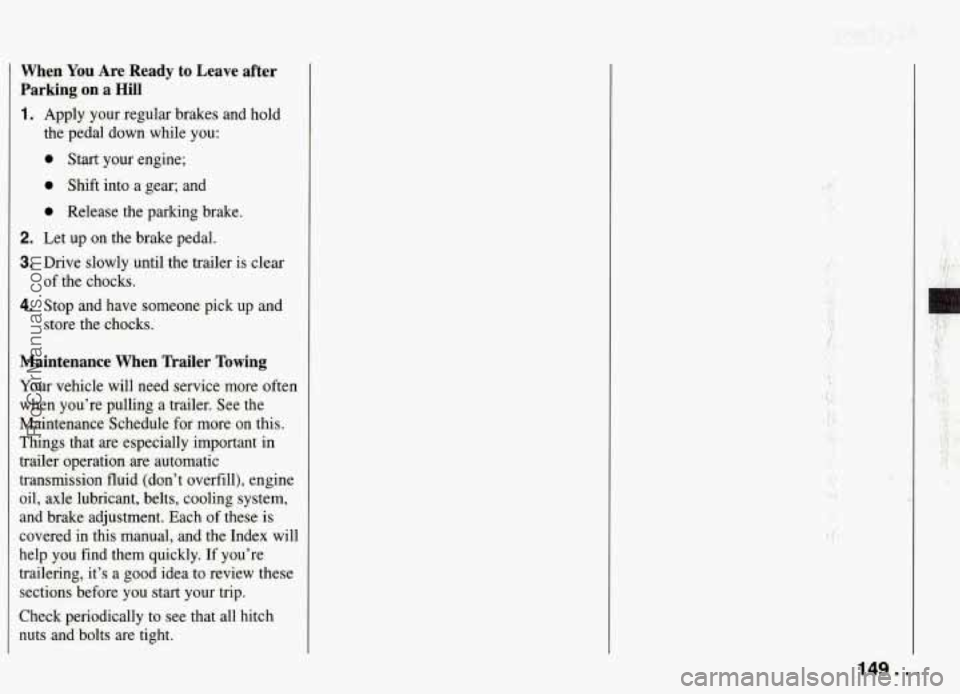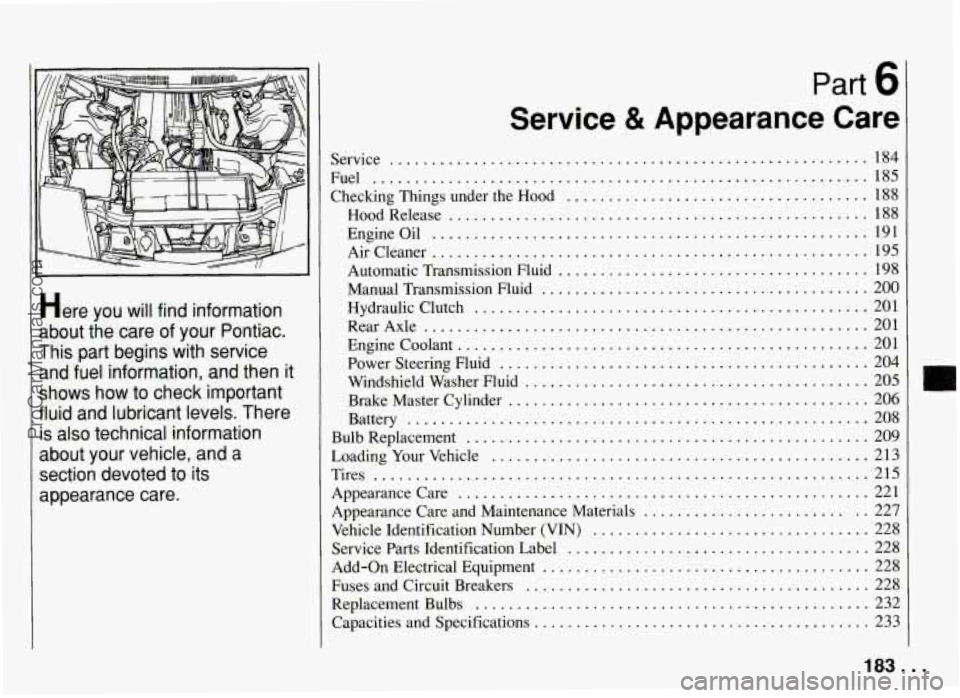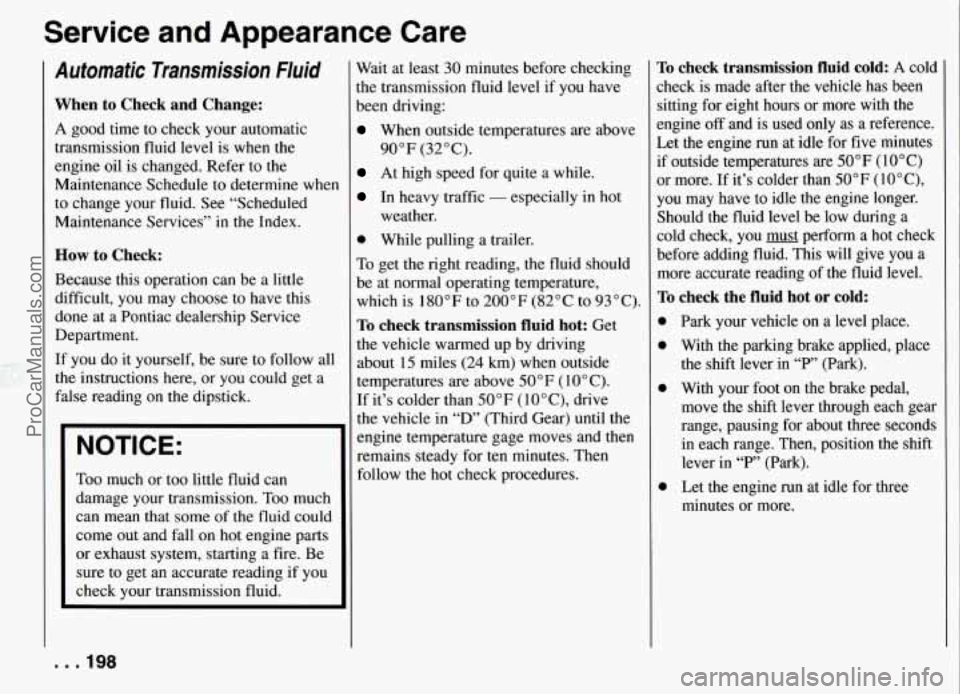check oil PONTIAC FIREBIRD 1994 Owners Manual
[x] Cancel search | Manufacturer: PONTIAC, Model Year: 1994, Model line: FIREBIRD, Model: PONTIAC FIREBIRD 1994Pages: 290, PDF Size: 14.84 MB
Page 97 of 290

Features and Controls
CHECK
GAUGES
Check Gages Light
This light will come on briefly when you
are starting the engine. If the light comes
on and stays on while you are driving,
check your gages to see
if they are in the
warning areas.
... 96
LOW
OIL
,ow Oil Light
!our vehicle is equipped with an oil level
nonitoring system. When you start your
ngine, the light will come on briefly. If
he light doesn’t come on, have it
epaired. If the light stays on after startine
‘our engine, your engine oil level may be
30 low. You may need to add oil. See
Engine Oil” in the Index.
I NOTICE:
The oil level monitoring system only
checks the oil level when you are
starting your engine. It does not keep
monitoring the level once your en- gine is running.
Also, the oil level
check only works when the engine
has been turned off long enough for
the oil to drain back into the oil pan.
ProCarManuals.com
Page 124 of 290

Care of Your Compact Discs
Handle discs carefully. Store them in theil
original cases or other protective cases
and away from direct sunlight and dust.
If the surface of a disc is soiled, dampen
a clean, soft cloth in a mild, neutral
detergent solution and clean it, wiping
from the center to the edge.
Be sure never to touch the signal surface
when handling discs. Pick
up discs by
grasping the outer edges or the edge
of
the hole and the outer edge.
Fixed Mast Antenna
The fixed mast antenna can withstand
most car washes without being damaged.
If the mast should ever become slightly
bent, you can straighten
it out by hand. If
the mast is badly bent, as it might be by
vandals, you should replace
it.
Check every once in a while to be sure
the mast
is still tightened to the fender.
123 ...
ProCarManuals.com
Page 141 of 290

Your Driving and the Road
The exit ramp can be curved, sometimes
quite sharply. The exit speed is usually
posted. Reduce your speed according to
your speedometer, not to your sense of
motion. After driving for any distance at
higher speeds, you may tend to thnk you
are going slower than you actually are.
Before Leaving on a Long Trip
Make sure you’re ready. Try to be well
rested.
If you must start when you’re not
fresh
- such as after a day’s work -
don’t plan to make too many miles that
first part of the journey. Wear comfortable
clohng and shoes you can easily drive
in.
Is your vehicle ready for a long trip? If
you keep it serviced and maintained, it’s
ready to go. If it needs service, have it
done before starting out. Of course, you’ll
find experienced and able service experts
in Pontiac dealerships all across North
America. They’ll be ready and willing to
help if you need it.
Here are some things you can check
before a trip:
Windshield Washer Fluid: Is the
reservoir full? Are all windows clean
inside and outside?
. . .I40
Wiper Blades: Are they m good
shape?
0 Fuel, Engine Oil, Other Fluids:
Have you checked all levels?
0 Lights: Are they all workmg? Are the
lenses clean?
0 Tires: They are vitally important to a
safe, trouble-free trip. Is the tread
good enough for long-distance
driving? Are the tires all inflated to
the recommended pressure?
Weather Forecasts: What’s the
weather outlook along your route?
Should you delay your trip a short
time to avoid a major storm system?
maps?
Maps: Do you have up-to-date
Highway Hypnosis
Is there actually such a condition as
“highway hypnosis”? Or is it just plain
falling asleep at the wheel? Call
it
highway hypnosis, lack of awareness, or
whatever.
There is something about an easy stretch
of road with the same scenery, along with
the hum of the tires on the road, the drone
of the engine, and the rush of the wind
against the vehicle that can make you sleepy. Don’t let
it happen to you! If it
does, your vehicle can leave the road in
less than a second, and you could crash
and be injured.
What can you
do about highway
hypnosis? First, be aware that it can
happen.
Then here are some tips:
0
0
0 Make sure your vehicle is well
ventilated, with a comfortably cool
interior.
Keep your eyes moving. Scan the road ahead and to the sides. Check your
rearview mirrors and your instruments
frequently.
If you get sleepy, pull
off the road into
a rest, service, or parking area and
take a nap, get some exercise, or both.
For safety, treat drowsiness on the
highway as an emergency.
ProCarManuals.com
Page 150 of 290

When You Are Ready to Leave after
Parking on a
Hill
1. Apply your regular brakes and hold
the pedal down while you:
0 Start your engine;
0 Shift into a gear; and
0 Release the parking brake.
2. Let up on the brake pedal.
.
3. Drive slowly until the trailer is clear
4. Stop and have someone pick up and
of the chocks.
store the chocks.
Maintenance When Trailer Towing
Your vehicle will need service more often
when you're pulling a trailer. See the
Maintenance Schedule for more on this.
Things that are especially important in
trailer operation are automatic
transmission fluid (don't overfill), engine
oil, axle lubricant, belts, cooling system,
and brake adjustment. Each of these
is
covered in this manual, and the Index will
help you find them quickly. If you're
trailering, it's a good idea to review these
sections before you start your trip.
Check periodically to see that all hitch
nuts and bolts .are tight.
I
I
149.. .
ProCarManuals.com
Page 164 of 290

On the V8 engine you’ll see this:
1. Coolant recovery tank
2. Radiator pressure cap
3. Electric engine fans
If the coolant inside the coolant recovery
tank is boiling, don’t do anything else
until it cools down.
When it
is cool, remove the coolant
recovery tank cap and look at the dipstick.
The coolant level should be at
or above
“FULL
COLD.” If it isn’t, you may have
a leak in the radiator hoses, heater hoses,
radiator, water pump or somewhere else
in the cooling system.
NOTICE:
Engine damage from running your
engine without coolant isn’t covered
by your warranty.
If there seems to be no leak, check to see
if the electric engine fan is running. If the
engine
is overheating, the fan should be
running.
If it isn’t, your vehicle needs
service.
163..
ProCarManuals.com
Page 184 of 290

I I
Here you will find information
about the care of your Pontiac
.
This part begins with service and fuel information. and then
it
shows how to check important
fluid and lubricant levels
. There
is also technical information
about your vehicle. and a section devoted
to its
appearance care
.
Part b
Service 8t Appearance Care
Service .........................................................
Fuel ...........................................................
Checking Things under the Hood ....................................
HoodRelease ..................................................
184
185
188
188
Engineoil
.................................................... 191
Aircleaner
.................................................... 195
Automatic Transmission Fluid
..................................... 198
Manual Transmission Fluid
....................................... 200
Hydraulic Clutch
............................................... 201
RearAxle
..................................................... 201
Enginecoolant
................................................. 201
Power Steering fluid
............................................ 204
Windshield Washer Fluid
......................................... 205
Brake Master Cylinder
........................................... 206
Bulb Replacement
................................................ 209
Battery
....................................................... 208
LoadingYourVehicle
............................................. 213
Tires
........................................................... 215
Appearance Care
................................................. 221
Appearance Care and Maintenance Materials
.......................... 227
Vehicle Identification Number (VIN)
................................. 228
Service Parts Identification Label
.................................... 228
Add-on Electrical Equipment
....................................... 228
Fuses and Circuit Breakers
......................................... 228
ReplacementBulbs
............................................... 232
Capacities and Specifications
........................................ 233
183 ...
ProCarManuals.com
Page 187 of 290

Service and Appearance Care
NOTICE:
Fuel that is more than 5% methanol
is bad for your vehicle. Don’t use it.
It can corrode metal parts in your fuel
system and also damage plastic and
rubber parts. That damage wouldn’t
be covered under your warranty. And
even at
5% or less, there must be
“cosolvents” and corrosion prevent-
ers in this fuel to help avoid these
problems.
Gasolines for Cleaner Air
Your use of gasoline with deposit control
additives will help prevent deposits from
forming in your engine and fuel system.
That helps keep your engine in tune and
your emission control system working
properly. It’s good for your vehicle, and
you’ll be doing your part for cleaner air.
Many gasalines are now blended with
oxygenates. General Motors recommend:
that you use gasolines with these blendin,
materials, such as MTBE and ethanol. BJ
doing
so, you can help clean the air,
especially
in those parts of the country
that have high carbon monoxide levels. n
addition, some gasoline suppliers are
low producing reformulated gasolines.
rhese gasolines are specially designed to
.educe vehicle emissions. General Motors
-ecommends that you use reformulated
;asoline. By doing
so, you can help clean
:he air, especially in those parts of the
:ountry that have high ozone levels.
You should ask your service station
3perators if their gasolines contain deposit
:ontrol additives and oxygenates, and
if
:hey have been reformulated to reduce
vehicle emissions.
Fuels in Foreign Countries
[f you plan on driving in another country
outside the
U.S. or Canada, unleaded fuel
may be hard to find. Do not use leaded
gasoline, If you use even one tankful,
your emission controls won’t work well
or at all. With continuous use, spark plugs
can get fouled, the exhaust system can
corrode, and your engine oil can
deteriorate quickly. Your vehicle’s oxygen
sensor will be damaged. All of that means
costly repairs that wouldn’t be covered by
your warranty.
To check on fuel availability, ask an auto
:lub, or contact a major oil company that
Joes business in the country where you’ll
,e driving.
You can also write us at the following
iddress for advice. Just tell
us where
you’re going and give your Vehicle
Identification Number (VIN).
General Motors Overseas Distribution
North American Export Sales (NAES) 1908 Colonel Sam Drive
Oshawa, Ontario
LlH 8P7
Canada Corporation
. . .I86
ProCarManuals.com
Page 192 of 290

OIL
Engine Oii
If the “LOW OIL” light on the instrumenl
panel comes on, it means you need to
check your engine oil level right away.
For more information, see
“Low Oil
Light”
in the Index. You should check
your engine oil level regularly; this is an
added reminder.
3.4L L32 (Code S)
It’s a good idea to check your engine oil
every time you get fuel. In order to get an
accurate reading, the oil must be warm
and the vehicle must be on level ground.
5.7L LTl (Code P)
Turn off the engine and give the oil a few
ninutes to drain back into the oil pan. If
’ou don’t, the oil dipstick might not show
he actual level.
191 ...
ProCarManuals.com
Page 193 of 290

Service and Appearance Care
To Check Engine Oil
(3.4L L32 (Code S) Engine)
Pull out the dipstick and clean it with a
paper towel or cloth, then push it back
in
all the way. Remove it again, keeping the
tip lower, and check the level.
To Check Engine Oil
(5.7L LT1 (Code P) Engine)
Pull out the dipstick slightly. Pinch the
end of the dipstick tube as you remove
the dipstick to wipe the oil from it. Then
push it all the way back in. Now remove
it without pinching the tube, keeping the
tip lower.
3.4L L32 (Code S)
When to Add Oil:
If the oil is at or below the “ADD’ line,
then you’ll need to add some oil. But
you must use the right kind. This section
explains what kind of oil to use. For
crankcase capacity, see “Capacities and Specifications” in the Index.
. . .I92
ProCarManuals.com
Page 199 of 290

Service and Appearance Care
Automatic Transmission Fluid
When to Check and Change:
A good time to check your automatic
transmission fluid level
is when the
engine oil is changed. Refer to the
Maintenance Schedule to determine when
to change your fluid. See “Scheduled
Maintenance Services” in the Index.
How to Check:
Because this operation can be a little
difficult, you may choose to have this
done at a Pontiac dealership Service
Department.
If you do it yourself, be sure to follow all
the instructions here, or
you could get a
false reading on the dipstick.
Too much or too little fluid can
damage your transmission. Too much
can mean that some of the fluid could
come out and fall on hot engine parts
or exhaust system, starting a fire. Be
sure to get an accurate reading
if you
check your transmission fluid. Wait
at least 30 minutes before checking
the transmission fluid level if you have
been driving:
When outside temperatures are above
At high speed for quite a while.
In heavy traffic - especially in hot
90°F (32°C).
weather.
While pulling a trailer.
To get the right reading, the fluid should
be at normal operating temperature,
which is 180°F to 200°F (82°C to 93°C).
To check transmission fluid hot: Get
the vehicle warmed up by driving
about
15 miles (24 km) when outside
temperatures
are above 50°F ( 10°C).
If it’s colder than 50°F ( lO”C), drive
the vehicle in
“D’ (Third Gear) until the
engine temperature gage moves and then
remains steady for
ten minutes. Then
follow the hot check procedures.
To check transmission fluid cold: A cold
check is made after the vehicle has been
sitting for eight hours or more with the
engine
off and is used only as a reference.
Let the engine run at idle for five minutes
if outside temperatures are 50°F
(10°C)
or more. If it’s colder than 50°F (lO°C),
you may have to idle the engine longer.
Should the fluid level be low during a
cold check, you must perform a hot check
before adding fluid. This will give you a
more accurate reading of the fluid level.
To check the fluid hot or cold:
0
Park your vehicle on a level place.
With the parking brake applied, place
the shift lever
in “P” (Park).
With your foot on the brake pedal,
move the shift lever through each gear
range, pausing for about three seconds
in each range. Then, position the shift
lever in “P” (Park).
Let the engine
run at idle for three
minutes or more.
. . .I98
ProCarManuals.com